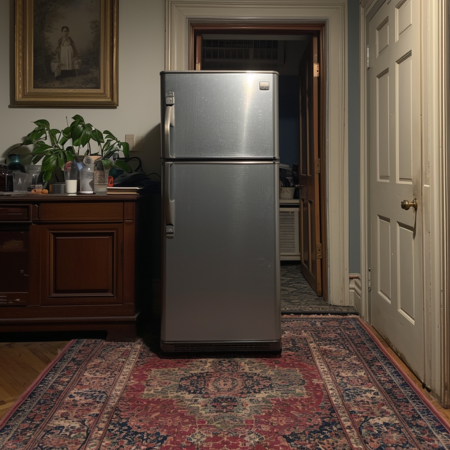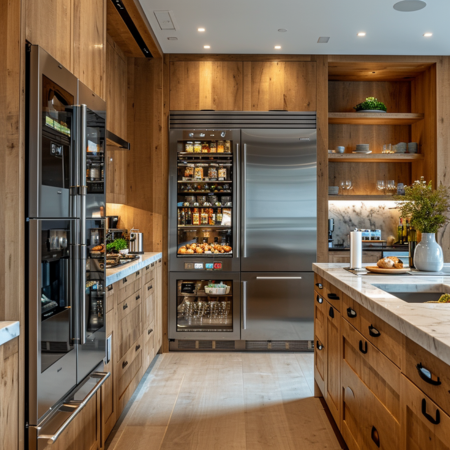When setting up a home or redesigning a space, placing appliances, particularly bulky ones like refrigerators, often raises questions.
One such question is, “Can you put a refrigerator on carpet?”
At first glance, placing your refrigerator on carpet might seem practical and simple, especially when trying to protect wooden floors or when space is at a premium.
However, the suitability of this setup is not as straightforward as it appears.
This article aims to shed light on the implications of placing a refrigerator on a carpet.
Key Points
- Heat Dissipation Issues: Carpets may obstruct the fridge’s heat dissipation.
- Potential Fire Hazard: Overheating could lead to a fire risk.
- Carpet Damage: A refrigerator’s weight may lead to permanent carpet damage.
Can You Put A Refrigerator On Carpet?
Contrary to popular belief, placing a refrigerator on the carpet is not recommended. Here’s why.
The carpet may obstruct airflow. Refrigerators need sufficient ventilation to function optimally. Carpets are known to restrict this flow.
Excessive heat can also be a problem. The refrigerator motor generates heat. The carpet material can trap this heat, causing the refrigerator to overheat.
This can lead to electrical hazards. Overheating might cause electrical components in the refrigerator to malfunction, potentially leading to a fire hazard.
Onto the durability of your carpet. The weight of the refrigerator can damage the carpet fibers over time. This can lead to an unsightly appearance and necessitate costly replacements.
Lastly, consider cleanliness. Spilled food and liquids can seep into the carpet causing stains and odors. Cleaning these from a carpet can be difficult.
Therefore, it’s best to place your refrigerator on a hard, flat surface. This ensures optimal functionality and safety. If you must place it on the carpet, use a robust, heat-resistant platform underneath.
5 Reasons Why Putting A Refrigerator On Carpet Is A Bad Idea
Placing a refrigerator on a carpet has more drawbacks than one might initially anticipate. Here are the primary reasons you should avoid such an arrangement:
1. Restricted Ventilation
Refrigerators need to breathe. When placed on a carpet, this process is hampered. Let’s dive into this further.
Air exchange is crucial. It allows the fridge to cool your food efficiently. Without it, your appliance struggles.
Carpets impede the fridge’s ventilation. They obstruct the necessary airflow around the appliance. This leads to complications.

Firstly, your fridge will overwork. The compressor will run more frequently to cool the inside. This leads to higher energy consumption.
Secondly, overheating becomes a problem. The trapped heat can cause the motor to overheat, leading to potential failure.
Hence, ventilation restriction is grave. It hits the efficiency of your refrigerator. It also risks the longevity of your appliance.
In conclusion, think twice before placing your fridge on a carpet. You might be compromising its ventilation. The result could be higher energy bills and a shorter lifespan for your fridge.
2. Overheating Risk
The risk of overheating is another reason not to place your fridge on a carpet. Carpets are insulators.
They trap heat. This creates an unwelcome environment for appliances like fridges.
Your fridge’s motor naturally produces heat. This heat needs to escape for the fridge to function properly.
A carpet makes this difficult. It traps the heat underneath the fridge.
As a result, the fridge can’t cool down. This causes it to work harder.
The harder your fridge works, the more heat it produces. It’s a vicious cycle.
Eventually, the motor may overheat. This can cause it to fail entirely.
Motor failure means a broken fridge. This is a costly repair. Often, it’s cheaper to buy a new fridge.
In summary, carpets increase the risk of your fridge overheating. This can lead to expensive repairs. Worse yet, it can shorten the lifespan of your fridge.
So, keep your fridge off the carpet. Your wallet will thank you.
3. Potential Electrical Hazards
Carpets can also introduce electrical hazards. Moisture is the primary culprit here. Carpets, unlike hard floors, can trap moisture.
This trapped moisture can seep into the electrical components of your fridge. Moisture and electricity are a dangerous mix. They can lead to electrical short circuits. This poses a risk of electrical fires.
Also, liquid spills on the carpet near the fridge go unnoticed often. These can seep through the carpet and reach the fridge’s electrical wiring.
Over time, this moisture can cause the wiring to corrode. Corroded wires can lead to electrical malfunctions. Again, this raises the risk of fires.
Even worse, a short circuit could electrify the fridge’s exterior if your fridge isn’t properly grounded. This puts anyone who touches the fridge at risk of electrical shock.
In essence, carpets can increase the risk of electrical hazards with fridges. Keep your fridge on a hard floor. Protect your home and loved ones from potential danger.
4. Carpet Damage
Fridges are heavy appliances. When placed on carpets, they exert a significant amount of pressure. This pressure can damage your carpet over time.
The carpet fibers get compressed due to the weight. As a result, you might notice permanent indentations where your fridge used to sit.
Moreover, moisture from the fridge can get trapped in the carpet. This can lead to the growth of mold and mildew. Over time, this can cause discoloration and degradation of your carpet.
Additionally, the constant movement of your fridge can cause carpet fibers to fray. This can lead to visible wear and tear on your carpet that’s hard to repair.
In conclusion, placing your fridge on a carpet can lead to significant carpet damage. It is best to keep your fridge on a hard, stable surface to prolong the life of your carpet.
5. Challenges in Cleanliness
Maintaining cleanliness becomes significantly more challenging with fridges on carpets.
Firstly, carpets tend to attract dust and crumbs. This accumulation around the fridge base is not easily visible or accessible. As a result, cleaning becomes a tedious task.
Secondly, carpets make it difficult to move the fridge. Achieving a thorough cleanup behind or underneath is almost impractical. This could lead to a build-up of dust and grime.
Moreover, any leaks or spills from the fridge can seep into the carpet. These are tough to spot and even tougher to clean. The moisture can cause odors and further soil the carpet.
Lastly, the warm fridge environment can promote bacterial growth on the carpet. This can lead to hygiene concerns, especially in areas where food is stored or prepared.
In summary, fridges on carpets pose cleaning challenges. For a clean, hygienic kitchen, placing your fridge on a hard, easy-to-clean surface is advisable.
Alternatives Of Carpet
Considering the problems of placing a refrigerator on a carpet, exploring viable alternatives is crucial.
These alternatives should provide stability, ease of cleaning, and longevity for your appliance. Here are five potential solutions to consider:
Hardwood Flooring
Hardwood flooring is an excellent option for placing your refrigerator. It’s sturdy and can handle the weight of heavy appliances.
The compact structure of hardwood prevents any indentations from the fridge. The floor remains smooth and unblemished.
Hardwood flooring is also easy to clean. Any spills or leaks from the fridge can be quickly wiped away without lingering moisture or stains.

Its robust nature makes hardwood resistant to the heat and humidity that a refrigerator can generate. There’s no risk of warping or discoloring due to temperature variations.
Moreover, hardwood floors provide a sleek, stylish look to your kitchen. They come in various colors and finishes, complementing any decor style.
Finally, moving a refrigerator for cleaning or rearrangement is easier on hardwood floors. The smooth surface allows for easy sliding without any damage.
In conclusion, hardwood flooring provides a practical and aesthetically pleasing alternative to carpet for your fridge.
Ceramic Tiles
Ceramic tiles are another suitable option for placing your fridge. They are hard and durable, offering substantial support to heavy appliances.
Like hardwood, ceramic tiles resist indentations from the fridge’s weight. This ensures a smooth, intact surface over time.
Cleaning is a breeze with ceramic tiles. Spills and leaks can be wiped away effortlessly.
Ceramic tiles handle heat and humidity well. They don’t warp or discolor under the fridge’s operational conditions.
In terms of aesthetics, ceramic tiles add a chic, modern look to your kitchen. They come in numerous colors and patterns, fitting perfectly with any decor style.
Moving your refrigerator on ceramic tiles is also quite simple. The smooth surface allows easy sliding, minimizing any potential damage.
In essence, ceramic tiles are a practical, stylish, and hassle-free alternative to carpet for your fridge.
Vinyl Flooring
Vinyl flooring is a viable choice for placing your fridge. It’s durable and can support the weight of heavy appliances.
The thick and resilient nature of vinyl flooring reduces the risk of indentations. Your floor remains smooth even under the heaviest of fridges.
Cleaning vinyl flooring is straightforward. Wipe spills effortlessly, maintaining a clean kitchen environment.
Heat and humidity are well tolerated by vinyl flooring. There’s no concern of warping or discoloration from your fridge’s operation.
Aesthetically, vinyl flooring offers flexibility. It comes in a variety of colors and patterns, aligning with any kitchen decor.
Vinyl flooring also allows easy movement of your fridge. The smooth surface permits sliding without damage.
In short, vinyl flooring is a durable, low-maintenance, and attractive alternative to carpet for your fridge.
Concrete Floor
A concrete floor is another excellent choice for placing your fridge. This flooring type is sturdy, and capable of withstanding heavy appliances without issue.
The strength of concrete means there’s little risk of indentations from your fridge. Your floor stays smooth, even under a behemoth fridge.
Cleaning a concrete floor is a breeze. Any spills can be quickly mopped up, leaving no residual mess.
Concrete handles heat and humidity admirably. There’s no threat of warping or discoloration from your fridge’s functioning.
Concrete flooring may not offer as many design choices as other materials. However, its minimalist, industrial look can be a unique addition to any kitchen decor.
Moving your fridge on a concrete floor is uncomplicated. The smooth surface makes sliding a straightforward task, reducing potential harm.
In short, for those seeking a robust, low-maintenance, and unique flooring option for their fridge, a concrete floor can serve as a practical alternative to carpet.
Conclusion
Evaluate your needs before deciding. Vinyl offers variety and resilience. It’s an ideal blend of practicality and aesthetics.
Concrete, on the other hand, is about strength and simplicity. It’s perfect for a minimalist, industrial vibe.
Both materials are easy to clean and can withstand weight. Therefore, your choice largely depends on personal preference.
- Can You Scrap A Microwave And Why You Should? - May 13, 2024
- Can You Put Metal In A Convection Microwave: 10 Major Risks - May 12, 2024
- Can You Use A Microwave Without The Glass: 10 Benefits - May 11, 2024

